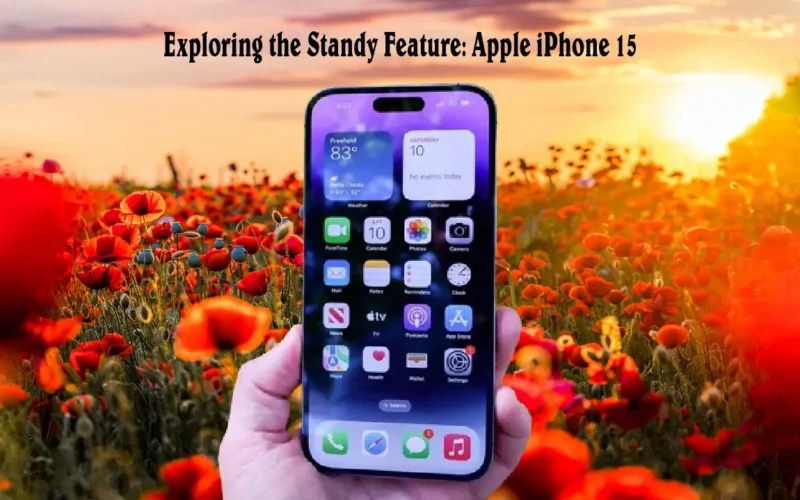Table of Contents Show
Exploring the Standby Feature in the Apple iPhone 15: A Comprehensive Guide
In our earlier analysis of the iPhone 15, we looked into the little details that go into making this phone a real gem in the world of smartphones. As we now turn our attention to the standby feature, we can see that one of these little details is the phone’s ability to manage its resources intelligently when it is not in use. The standby feature is a subtle but effective aspect of the iPhone 15, signifying Apple’s dedication to improving the user experience through the seamless integration of innovative functionalities. It is in these little details that users can truly appreciate the sophisticated design and cutting-edge technology that together define the iPhone 15’s position at the forefront of smartphone innovation.
Introduction to the Standby Feature in the Apple iPhone 15:
One of the most notable features of the most recent iPhone 15 is the improved standby feature. In this extensive guide, we will investigate the details of this feature, exploring its advantages, pros, and cons, and comparing it with similar features on other smartphones. Apple has continually pushed boundaries in the ever-evolving world of smartphones to provide users with innovative and user-friendly features.
Understanding the Standby Feature in the Apple iPhone 15:
The Standby feature in the Apple iPhone 15 elevates the idea of battery optimization to a new level by introducing a dynamic system that intelligently manages the phone’s resources during inactivity. When the device is not in use, the standby feature optimizes background processes, modifies screen brightness, and controls connectivity to ensure minimal power consumption. Additionally, you can use the Standby feature to transform your iPhone into a photo frame, a bedside clock, or a display for full-screen gadget movies or live activities.
Standby lets you quickly and easily access the information that matters most to you with a glance. Initially, Apple displays data from the native Calendar, Clock, and Reminders app, but third-party apps are also supported, provided that the developer chooses to do so. Some people think Standby is just a way to make your iPhone into a digital clock, but it is much more than that.
How to enable the standby feature in the Apple iPhone 15
As soon as you update your iPhone 15 to iOS 17, Standby is set by default. However, you can double-check this by going into the Settings app and finding the toggle switch for Standby under Standby. To activate it, your iPhone must also fulfill certain prerequisites. Particularly, it must be locked, in landscape mode, charging, and not resting flat on its back.
- Even if your iPhone is sitting on the home screen, the standby mode will not activate unless it is on the lock screen. If it isn’t, standby mode may interfere with your current activity.
- The iPhone needs to be connected to a power source to charge.
- The last step is the trick: your iPhone must be angled at least 30 degrees from horizontal for Standby mode to engage, as it is designed to work as a smart display and will not engage if you lay it down.
Unfortunately, the screen will only stay on if you are using an iPhone with an always-on display, which comes only in iPhone 14 Pro, iPhone 14 Pro Max, iPhone 15 Pro, or iPhone 15 Pro Max. With other iPhone models, you will only get 30 seconds before it shuts off, likely lowering the risk of screen burn-in. Unfortunately, Standby Feature will work on any iPhone that can be updated to iOS 17 — back to the 2018 iPhone XS/XS Max and iPhone XR
The Standby feature will turn back on when movement is detected, or when you tap your iPhone or call out to it with a hands-free Siri request. The screen will turn off even with an always-on display at night or any other time when your iPhone thinks it does not need to be on, like when it knows from your Apple Watch that you are at the other end of your house.
As long as your iPhone is charged and positioned in a landscape orientation, the Standby feature will function with any stand. This means you can program your iPhone to automatically display an album of photographs when you dock it in your living room, useful widgets in your kitchen, and a clock on your nightstand.
Benefits of the Standby Feature in the Apple iPhone 15:
- Extended Battery Life: The main benefit of the standby function is its ability to prolong the battery life of the iPhone 15. It does this by managing background activities and connectivity in an intelligent manner, which allows the device to save energy during inactive periods and lets users go longer between charges.
- Enhanced Performance: With the Standby function, Apple has combined its focus on power economy with performance optimization. The device optimizes background processes to ensure that it is responsive and ready to provide a seamless user experience when the user resumes activity.
- Customization Options: Users can adjust the settings to customize the standby feature based on their usage patterns. This flexibility allows for a personalized balance between power savings and performance. The user can customize the Standby feature to any of his choices from the list of many customizing options. Apple recognizes that user preferences vary.
Pros of the Standby Feature in the Apple iPhone 15:
- Clever Resource Management: With the help of sophisticated algorithms, the Standby feature analyzes usage patterns and modifies resource allocation to provide a seamless user experience without sacrificing battery life.
- User-Friendly Interface: Apple has taken care to make sure that customers can easily access and customize the Standby feature. The intuitive interface makes it simple for consumers to change the settings according to their needs and tastes.
- Adaptive Connectivity: Based on the user’s location and activities, the feature optimizes connectivity options, including Wi-Fi and cellular data, to make sure the device stays connected when it is needed and saves energy when it is not.
Cons of the Standby Feature in the Apple iPhone 15:
- Learning Curve for Users: Apple should concentrate on giving clear and simple instructions to assist consumers in making the most of this feature, even if the Standby feature is meant to be user-friendly. However, some users may find it difficult at first to understand the customization possibilities.
- Dependency on System Intelligence: The accuracy with which the device can forecast user behavior is a major factor in how well the standby feature works. In certain situations, the system may not be able to foresee user needs, which could result in less-than-ideal performance.
- Compatibility with Third-Party Apps: Third-party apps may not all be fully tuned to function seamlessly with the Standby feature, which could influence battery life and performance. As a result, the usefulness of the standby feature may vary depending on the app.

Comparison with Similar Features in Other Phones:
- Samsung’s Adaptive Battery: Both Apple’s Standby and Samsung’s Adaptive Battery features, which are found in the company’s flagship Galaxy series, use machine learning to optimize power consumption; however, the Apple Standby feature takes a more comprehensive approach by managing system resources, whereas Samsung’s approach is more focused on learning specific app usage patterns.
- Google’s Adaptive Battery on Android: Android devices that run on the Google ecosystem frequently have the Adaptive Battery feature. Like Apple’s Standby, this feature uses AI algorithms to recognize patterns of usage and modify power allocation. The way these algorithms are implemented varies amongst Android manufacturers, which can result in variations in performance.
- OnePlus’ Zen Mode: With Zen Mode, OnePlus offers an alternative approach to optimizing the user experience, emphasizing user well-being over power optimization. Although it is not directly comparable to the standby feature, Zen Mode encourages users to take breaks from their devices for a predetermined amount of time.
Conclusion:
With its ability to intelligently manage resources during idle periods, Apple hopes to achieve a balance between providing the best possible user experience and prolonging battery life. The standby feature of the Apple iPhone 15 is a significant innovation in smartphones, and although it has drawbacks, it improves the overall user experience.
The way that different manufacturers tackle the challenge of striking a balance between performance and power efficiency is fascinating to watch as the smartphone landscape continues to evolve. The iPhone 15’s standby feature is a positive step in the right direction, setting the industry standard for intelligent resource management.
What is the iPhone 15’s standby feature exactly?
The iPhone 15’s standby feature is a sophisticated power-saving technique that optimizes the device’s resources while it is not in use. It does this by controlling connectivity, adjusting screen brightness, and intelligently managing background operations to minimize battery usage.
What role does the standby function play in longer battery life?
By actively controlling background operations and connectivity when the device is not in use, the Standby feature helps to prolong battery life by minimizing needless power use and enabling users to enjoy longer times between charges.
Is it possible for users to customize the Standby feature to their preferences?
Yes, Apple is aware that different users have different tastes. That is why the standby function includes customization choices that let users adjust the settings according to how they use the device. This allows consumers to customize how much power savings they want while still getting the performance they need.
Is predictive intelligence used by the Standby feature, and if so, is it always accurate?
The effectiveness of the standby function depends on how well the device anticipates user behavior. Although it works well most of the time, there could be times when the system mispredicts user needs, which could result in less-than-ideal performance.
Can apps from third parties affect how well the standby function works?
Indeed, the effectiveness of the standby feature might differ depending on third-party apps. It is advisable to keep apps updated to guarantee compatibility with the latest system optimizations, as some apps might not be fully optimized to work seamlessly with this feature, potentially affecting both performance and battery life.
Does the standby feature impact cellular data and Wi-Fi connectivity options?
Indeed, the Standby feature optimizes connectivity options—like Wi-Fi and cellular data—according to the user’s activities and location. This keeps the device connected when it is needed and saves energy when it is not.




![How To Add Cozi Widget To iPhone 2024 [5 Simple Steps] 4 How-To-Add-Cozi-Widget-To-iPhone](https://mobilehurt.com/wp-content/uploads/2024/04/How-To-Add-Cozi-Widget-To-iPhone-110x110.webp)


![How To Find Apple ID Password Without Resetting It? [5 Easy Ways] 16 How To Find Apple ID Password Without Resetting It](https://mobilehurt.com/wp-content/uploads/2024/04/How-To-Find-Apple-ID-Password-Without-Resetting-It-260x195.jpg)

